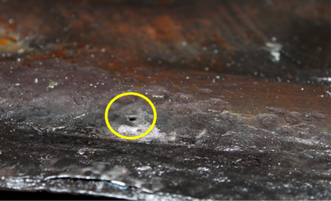

GAS-FIRED BAKERY OVEN
This case involved a fire in the UK, of a £5 million (AUD $10 million) gas-fired bakery oven specialising in making large and small muffins. The muffins are prepared at the front of the production line, the mix is then added, and the muffins then enter the bottom of the oven and are baked by passing eight heated oil plates. They are then passed through onto the cooling area and cooled before passing back below the oven area to be processed for packaging. This heating process involved the oil being heated before being circulated through a series of pipework to the heat plates within the oven area.
Exterior examination of the preparation area revealed no damage to this area. The internal oven area was heavily damaged by heat and smoke. The chain drive belts and heat plates were damaged with some aluminium cast cogs, which melted, indicating during the fire a temperature of over 660°C.
Examination of the top three horizontal heat plates revealed evidence of heat stress which had expanded due to the fire heating the remaining oil and air with the plates. On closer examination of the heating plates under magnification, a 2 to 3 mm pinhole was observed in the third plate from the top of the oven.
In discussion with the Manager, the machine was changing from the production from small muffins to large muffins. On opening the oven door, the operators observed a piece of charcoal debris on the heat plate. As operatives wiped the residual charcoal, a pinhole was established within the heat plate. The resulting pinhole, allowed the release of the vaporised oil and was subsequently ignited by the residual heat from the metalwork within the oven area.
The operating temperature of the oven is approximately 260-280°C. The auto-ignition temperature (e.g. closed cup) of the oil is 349°C. However, pressurisation and vaporisation of the oil lowers the auto-ignition temperature to below that of the normal auto-ignition temperature at which the oil ignites, allowing for hot surface ignition of the oil.
A recorded cleaning schedule of the oven interior was not evident. If the cleaning and maintenance had been regular and a build-up of charcoal may have been avoided.
The process of cleaning the internal plate area of the production area, utilises a compressed air pressure lance to blow away debris. The pressurised air jet likely contributed to the pinhole associated with the heating plate.
The oven's Operations Manual clearly states the daily schedule for cleaning "Open doors along both sides of the oven when it has cooled and clean out any baking debris which may have fallen from pans etc.". The procedure, in this instance, was not done.
Therefore, it is always important to follow the manufacturer's instructions when carrying out any cleaning and maintenance of equipment.




